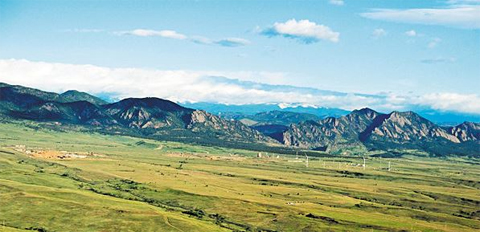
Did you realize that PLAN Jeffco and Jefferson County Open Space are an integral part of a world wide effort to deal with massive environmental problems such as global warming, climate change, deforestation, mass extinction and water pollution? Well, we didn’t either until we read Tom Friedman’s op-ed piece in the New York Times Sunday Review Section on November 23, 2014 entitled “Stampeding Black Elephants”.
So what’s a Black Elephant? When Friedman was at the recent World Parks Congress in Sydney, Australia, he heard this term used for the first time. The Black Elephant is a cross between “…‘a black swan’ (an unlikely, unexpected event with enormous ramifications) and ‘the elephant in the room’ (a problem that is visible to everyone, yet no one still wants to address it).”
The Black Elephant in question is the plethora of environmental issues which are influencing each other — global warming, deforestation, ocean acidification, mass extinction and massive fresh water pollution. These tragedies strike and we claim they’re unpredictable black swans. In truth they’re the elephant which is already in the room.
The Congress brought together some 6,000 scientists and environmentalists from around the globe, all of whom were focused on the same goal: “guarding and expanding protected areas, which are the most powerful tools we have to restrain the environmental black elephants.”
Russ Mittermeier, one of the world’s leading primatologists, said to Friedman that “…protected forests, marine sanctuaries and national parks are not zoos, not just places to see nature. They are the basic life support systems that provide the clean air and water, food, fisheries, recreation, stable temperatures and natural coastal protections that sustain us humans…”
This article brings a global perspective to what we’re trying to do in Jefferson County, in preserving and conserving our open spaces. Friedman cites perspective after perspective, from countries across the world, and they all point to a common thread of thought…our open spaces and “parks are really the heart, lungs, and circulatory systems of the world — and they’re all endangered.” You can read the entire column in the New York Times online, at
http://www.nytimes.com/2014/11/23/opinion/sunday/thomas-l-friedman-stampeding-black-elephants.html?rref=collection%2Fcolumn%2Fthomas-l-friedman&_r
(The New York Times is a subscription-based newspaper; a paid subscription may be required.)
 Mountain Area Land Trust (MALT) has closed on a Conservation Easement on a beautiful 71 acre property near Bailey. The property has breathtaking mountain and river views and includes a half-mile of river frontage on the North Fork of the South Platte River. This Conservation Easement will ensure that the property’s wildlife habitat and scenic vistas will be conserved forever. Read about MALT’s latest CE successes at http://www.savetheland.org/latest-news
Mountain Area Land Trust (MALT) has closed on a Conservation Easement on a beautiful 71 acre property near Bailey. The property has breathtaking mountain and river views and includes a half-mile of river frontage on the North Fork of the South Platte River. This Conservation Easement will ensure that the property’s wildlife habitat and scenic vistas will be conserved forever. Read about MALT’s latest CE successes at http://www.savetheland.org/latest-news





